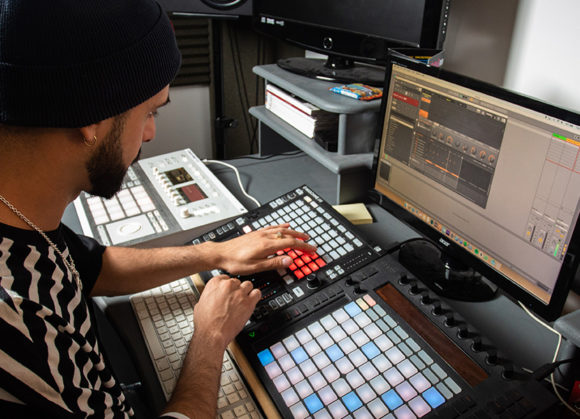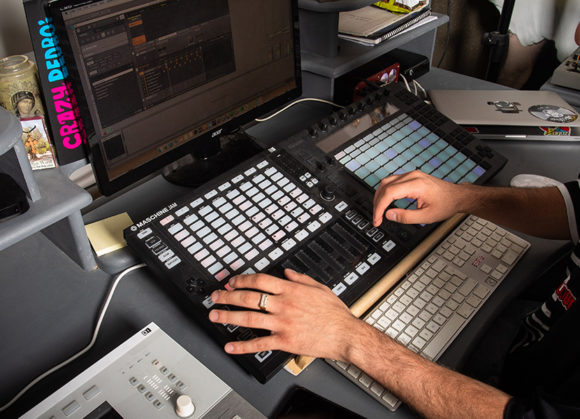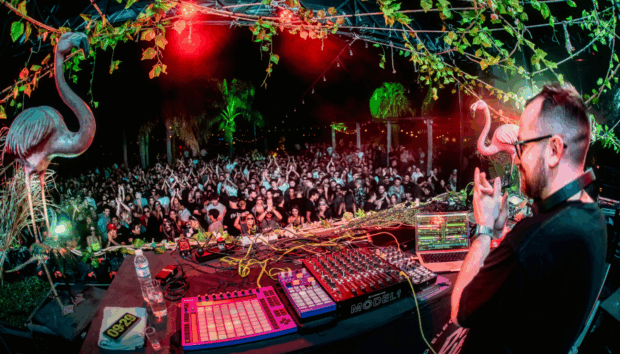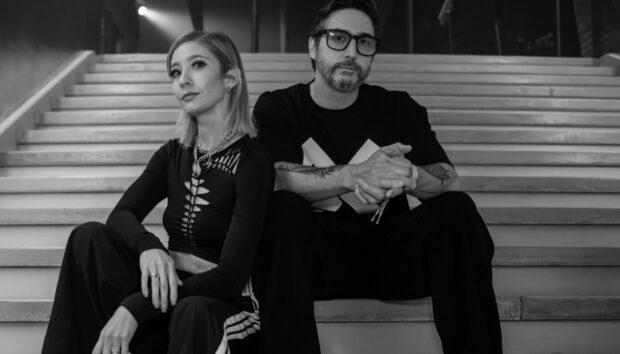Manchester’s AJ Christou has proven himself to be an adept, consummate within the music scene, through his much-lauded productions, DJ dexterity, and through the establishment of his label, Celesta Recordings. Starting out as a teen resident at Sankeys, AJ Christou moved to New York to enroll in a sound design course, learning to produce using select Native Instruments gear. Since then he went on to release a ream of records with big-name labels, while also finding time to put on records independently.
We spent time speaking with the Native Instruments fanatic to find out what his setup looks like and how he manages so many elements in his output.
Let’s start with the basics. What does your studio setup look like?
I used to have a setup at my house, but now I have a studio in Manchester where I go from ten in the morning until seven in the evening to work on production. All I have at home now is just two speakers and the Traktor Kontrol S4, which I use for gig preparations. When I’m downloading music I like to use the S4 to test tracks out because sometimes I download a track that sounds cool but it might not sound good in the mix. So, I use the S4 to do all my prep, practising with the remix decks and just overall jamming when I don’t feel like driving into the city to go to the studio.
What prompted you to move your studio out of your home and into the city?
I have a loud Greek family! There’s always friends and family coming round so I was easily distracted. I like to separate home from work, so when I go to the studio I treat it like a job. I have my own DJ booth in there and all my production equipment. Also, [because] I lived in New York for a while, when I came back I missed being in the city, so I found the studio in Manchester.
How did that time living in New York influence your approach to music making?
While in New York, I was doing a sound design course that used Native Instruments gear, which I’ve stuck with ever since. All the Native stuff is such high quality: the samples are great, the synths are amazing and the Kontakt libraries are crazy – you can pretty much get any sound you want. I use Ableton Live, plug-ins and Reaktor and Massive, which I use the most. Reaktor is such a big thing for me. It’s amazing for creating ideas if you have a bit of a block in the studio, you can just open the groove box and make something totally unique and crazy to build around. You’ll find some really nice glitchy sounds in there that fill out your tracks and give them more swing. If you listen to ‘Right Now‘, out now on my most recent EP on Celesta Recordings, you’ll hear it has this skippy groove underneath, which was made with a groove box in Reaktor. I positioned everything on the step-sequencer and it made a really nice rhythm, which was basically the foundation for the whole track. Then I just added the bassline and built out from that groove.

How does the S4 fit into your workflow?
The way the decks are set up with the pads underneath the jog wheel is great, because all your cue points are there and you can just hit the pads when there’s a section of a track you like. For example, I downloaded a track the other day and the first two minutes were really cool, but after the drop this noise came in which I didn’t like, so I created a loop on the deck and as the track dropped I hit the pad on the S4 to skip back to the loop before. Basically, instead of dropping into where that sound I didn’t like came in, I could time it so it dropped back into the section that I did like. Also, it’s cool that you can flick between all four decks: I can use the jog wheels on any of the decks by just clicking ‘A’ and ‘B’ and then I can use the pads with the remix decks. I don’t tend to use controllers very often but this is one of the first ones I’ve really enjoyed playing on. It feels like a good mixer: It’s sturdy, I can jam on it for hours and it’s fun to play with.
How do you use MASCHINE in your own productions?
I actually have Maschine Jam and Maschine Studio as well as Maschine. I am such a massive fan of Maschine Jam. With my tracks and my drums, it’s all about layering things and making them sound really thick, and that’s how I like to use it. I can make a groove in minutes with Maschine Jam. You load in your drums – I use the pre-kits or my own samples from the Maschine kits – and once I’ve got all the samples I want to use in the rack, it’s easy to pattern a drum loop together with the step sequencer or just play the notes in. I actually always get the Expansions whenever an interesting one comes out with fresh sounds because all the samples are so well treated that they sound pretty much perfect when you put them together. I don’t stick to just one pack – I’ll have all my Expansion packs loaded and I go through and find a kick that I like, then a hat, then a clap. After I’ve got all the sounds I like, I’ll make my first groove. Then I’ll go to the next bank and keep layering depending on the style of track. The Pulsewerk pack is great; that’s a go-to of mine for minimal sounds. When I’m choosing my tracks, that’s where Maschine Studio comes in. I use the little jog wheel to pick my samples and I like it for editing as well – making the sample shorter or adding a reverb or effect.
Do you use Native Instruments when you’re DJing live, too?
Yeah, absolutely. I played abroad in May, first in New York for the Rawthentic boat party and then in Ecuador, where I used Traktor. I just bought a new laptop and installed the new Traktor Pro 3. I’ve been going through my entire digital library and doing lots of prep so that when I’m in Traktor, I know where all the different styles of music are. I have a lot of music but I’m not necessarily playing everything when I’m out, so I’ve started using the color coding in Traktor and it’s amazing. It helps me narrow down what I’m going to play by helping to pull out different energies and vibes. If I’ve got a track with bright sounds the colour of that track will be blue, so when I’m playing and I want a track that sounds bright I just have to look at the screen and I can see exactly where all the tracks are. For me that was a massive feature. I’m so happy it was added.
How do you balance your own work with touring and making music?
You have to find that balance. I used to try and do everything every day and it really didn’t work for me. Now I spend two days a week just listening to and preparing music I want to play. Then I do all my Celesta stuff on Monday and Friday. The rest of the week is making music and production, but on the weekend I do whatever I want – if I feel creative I go to the studio, if I don’t I won’t. For me, it’s so important to stay organized and to have a set up that works because If I don’t stay organised I get sloppy. Of course, you can’t ever really prepare for a set because you might get to the club and it’s a totally different vibe to what you had in your head, so the colour coding and playlisting for different vibes which I just spoke about means that you can adapt. That’s key! There’s no panic or standing there scrolling through tracks. I never want to go to a gig and feel unprepared and not show up for it. Traktor makes it so easy to access music. There’s no more using the little screens on CDJs to find all your tunes. Now, I’ve got my laptop, my keyboard and my colour coding. It’s such a game changer.
And finally, you’ve been releasing work on Celesta as well as working with lots of other big-name labels for a while now. Is there anything you wish you’d known about working with labels when you first started out?
When I first started making music I put everything that I made and it was only later that I was able to develop my own style and realise the direction I wanted to go in. Looking back, I wish I had been a little more patient and got to know myself better in terms of the sound I was looking for and the direction I wanted to go in. I would say to anyone starting out to be patient and think about the direction you want to go with because that opens the window for which labels you want to work with. Don’t always focus on making that hit track and signing to any label. Take your time, think about it and make sure you’re 100% with all your work.
photo credits: Karina Lax



















